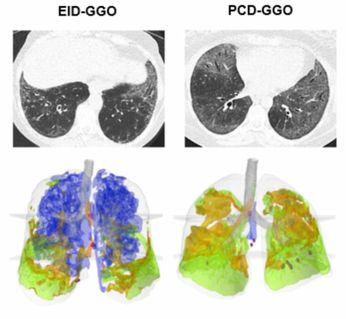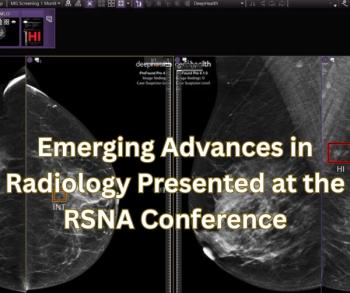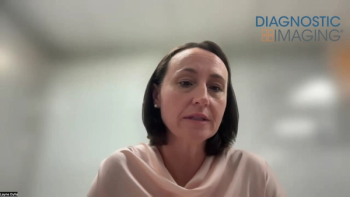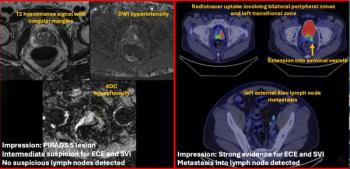Emerging research suggests that photon-counting computed tomography (PCCT) may bolster T-staging for rectal cancer and offer comparable accuracy to rectal magnetic resonance imaging (MRI).
For the prospective study, recently published in Radiology, researchers assessed the use of PCCT for enhancing image quality for rectal cancer tumors and compared the modality’s accuracy to that of MRI for preoperative tumor staging in 72 patients (mean age of 61) with rectal adenocarcinoma.
In the image quality analysis, the study authors found that increasing levels of quantum iterative reconstruction (QIR) with PCCT were correlated with reduced image noise as well as increased signal-to-noise ratio (SNR) and contrast-to-noise ratio (CNR).
With QIR-4 and a decrease of virtual monoenergetic images (VMIs) from 70 to 40 keV, the researchers saw a 110 percent increase in tumor attenuation (from 94.1 HU to 198 HU) and 170 percent increase in tumor contrast (from 37.8 HU to 102 HU).
“We showed that as kiloelectronvolts decreased, tumor attenuation and tumor contrast improved regardless of the QIR level, whereas the image noise increased. Meanwhile, higher QIR levels remarkably reduced image noise without altering tumor contrast. Thus, low kiloelectronvolt (ie, 40 keV) combined with high QIR level (ie, QIR-4) maximized both signal-to-noise ratio and contrast-to-noise ratio for RCs. Qualitative image assessment also favored 40 keV with QIR-4 for superior tumor conspicuity and margin clarity, which are crucial for precise tumor T staging,” wrote lead study author Lina Zhu, M.D., who is affiliated with the Department of Radiology at the First Affiliated Hospital of Zhengzhou University in Zhengzhou, China, and colleagues.
Rectal MRI offered higher overall average accuracy for rectal tumor staging (73.3 percent vs. 70 percent) and higher average sensitivity for T3-T4 staging (90.3 percent vs. 87.6 percent) in comparison to optimal PCD CT, according to the study authors.
However, the researchers pointed out that for T3-T4 staging, optimal PCD-CT offered comparable average AUC (82.6 percent vs. 82.7 percent) and accuracy (82.7 percent vs. 82.7 percent) as well as slightly higher average specificity (77.7 percent vs. 75 percent) in contrast to rectal MRI.
Three Key Takeaways
• Optimized PCCT markedly improves rectal tumor conspicuity.
Use of low-keV VMIs (40 keV) combined with high-level quantum iterative reconstruction (QIR-4) substantially increased tumor attenuation and contrast while reducing image noise, enhancing margin clarity essential for accurate T-staging.
• MRI remains slightly more accurate overall, but PCCT achieves comparable performance for advanced (T3–T4) disease. While MRI showed higher average accuracy for overall staging and higher sensitivity in T3-T4 staging, optimal PCCT provided nearly identical AUC and accuracy for T3–T4 tumors and offered slightly higher specificity.
• PCCT is a viable alternative or adjunct when MRI is limited.
Optimal PCCT may be particularly useful for patients who cannot undergo MRI or in cases involving MRI artifacts. PCCT may also boost junior readers’ performance for T3-T4 staging in comparison to standard polychromatic CT.
“Optimal PCD CT achieved diagnostic performance in T staging comparable to that of MRI, which remains the preferred modality for local staging of RC,” added Zhu and colleagues. “PCD CT is particularly advantageous for patients with contraindications to MRI because it can provide a practical and efficient imaging alternative. Furthermore, PCD CT offers an adjunctive modality to MRI, especially when MRI has artifacts.”
The study authors also noted that optimal PCD CT facilitated 16 to 18 percent higher AUCs than polychromatic imaging for T3-T4 staging by junior radiologists.
(Editor’s note: For related content, see “Could Lymph Node Distribution Patterns on CT Improve Staging for Colon Cancer?,” “Can Abbreviated MRI Have an Impact in Rectal Cancer Staging?” and “Can MRI-Based AI Enhance Pre-Op Prediction of Tumor Deposits in Patients with Rectal Cancer?”)
Beyond the inherent limitations of a single-center study, the authors acknowledged limiting CT acquisition to venous phase imaging, the lack of assessing potential reduction of radiation dosing with quantum iterative reconstruction (QIR) and low virtual monoenergetic images (VMI) levels, and the relatively small cohort size.





























